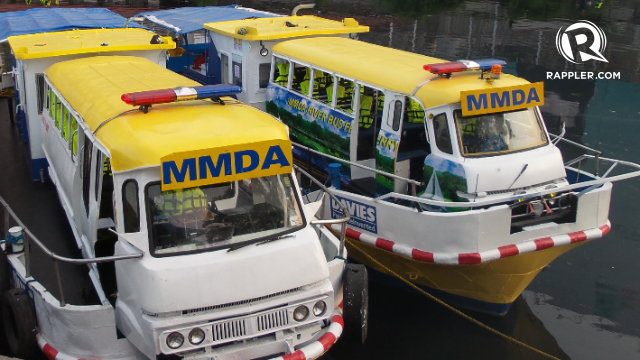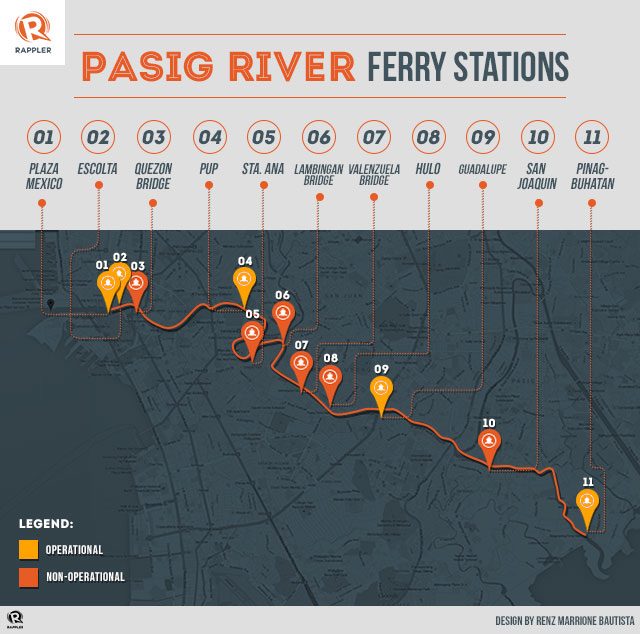SUMMARY
This is AI generated summarization, which may have errors. For context, always refer to the full article.

MANILA, Philippines – The boats are more modest, and the stations are fewer. But the government sees the “revived” Pasig River ferry system as a keeper.
For starters, the Metropolitan Manila Development Authority (MMDA) has learned an important lesson from ferry systems past: make sure your ferries match the demand.
“Smaller boats are easier to load, to fill up compared to 150. It took so long to leave, that’s why they didn’t earn before,” MMDA chief Francis Tolentino explained. The previous ferry system, operated by the SCC Nautical Transport Services Incorporated, were suspended due to loses.

“Jumbo jet yung dati, eh domestic airport lang ang bababaan, so hindi makapuno,” he added. (We were using jumbo jets when we were only landing in domestic airports.)
On Monday, April 28, the MMDA, Department of Transportation and Communications (DOTC) and the Pasig River Rehabilitation Commission (PRRC) led the re-launch of the Pasig River Ferry System.
It was only a “soft opening,” DOTC Undersecretary Rene Limcaoco explained, since the MMDA and DOTC have yet to iron out the finer details of the new system such as the final pricing scheme.
But will this incarnation of the ferry system work this time?
Month-long ‘birthing pains’
Tolentino is quick to admit that the first month of operations won’t be pretty. “You’ll see birth pains,” he added.
The first day of the system proved Tolentino’s point. Would-be passengers were left waiting at the Polytechnic University of the Philippines (PUP) station in Santa Mesa, Manila.
It turns out that the bus ferry could only travel from the Guadalupe station in Makati to the Pinagbuhatan station in Pasig City because of US President Barack Obama’s arrival in the Philippines. Full operations, said Tolentino, will start Tuesday, April 29.
For now, the Pasig River ferry system involves 3 private groups running 3 routes, dropping passengers off in only 5 stations. Tolentino said 6 other existing terminals “will be activated within the year.”

Tech-savvy ferry passengers can also look forward to an Android app that will be released soon. The app will allow passengers to see estimated times of arrival and departures of the different boats at the 5 initial terminals.
Stench persists
Only 5 boats are part of the system for now – a 32-seater ferry, two bus ferries and 2 “jeepney ferries” that fit 12 people.
Politicians and commuters alike see the Pasig river as a solution to Metro Manila’s traffic woes, especially in light of a series of simultaneous road construction projects from 2014 to 2016. (READ: Pasig River: Solution to Metro Manila traffic?)
The trip from Guadalupe to Pinagbuhatan took less than 40 minutes – time spent getting lost included. But the size of the boats wasn’t the only reason the last ferry system shut down – people didn’t want to ride the ferries because of the pollution in the river.
The stench persists, and is hard to forget even if you’re on dry land. Garbage and wayward plants also get in the way of the boats’ engines, stalling trips from time to time.
Pricing, ‘interconnectivity’
Tolentino said a lot of things need to be ironed out – ticketing systems and final pricing, among them. For the first week of the system’s return to service, trips will be free, with free coffee to boot.
Limcaoco said it will take 2-3 months before the DOTC can figure out a final pricing scheme. “You have to get a large enough sample data to see…and get market feedback to see what they think of the pricing, response, whether the ridership is good because of its pricing,” he told Rappler.
Until then, the Pasig River ferry system will cost between P25 to P50.
In February this year, Senator Ralph Recto urged national government to tap its funds to jumpstart the revival of the ferry system. Limcauco said “it wasn’t easy” to find operators for the project.
“We had to convince [them]….We had to look for interested operators. [But] once we worked with them and discussed plans, the interested operators started coming out of the woodwork,” he said.
By Wednesday, April 30, Tolentino said the MMDA will release a map showing how the ferry system “connects” to existing modes of transportation in the metro. The long-term plan, he added, is for the ferry system to be integrated into the Metro Rail Transit and Light Rail Transit.
For now, the Bonifacio Global City (BGC) bus central route now includes the Guadalupe terminal as one of its stops. – Rappler.com
Add a comment
How does this make you feel?
There are no comments yet. Add your comment to start the conversation.